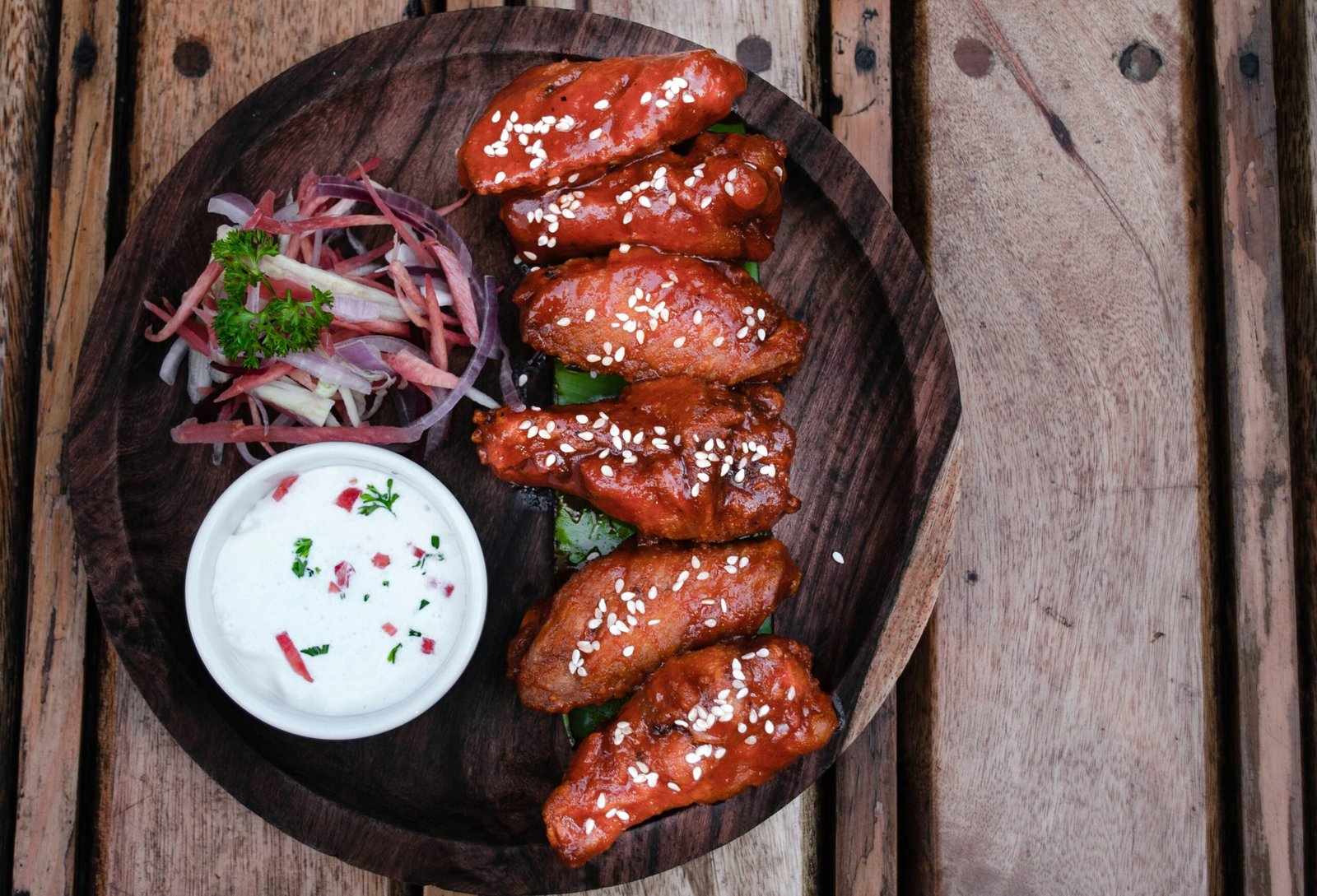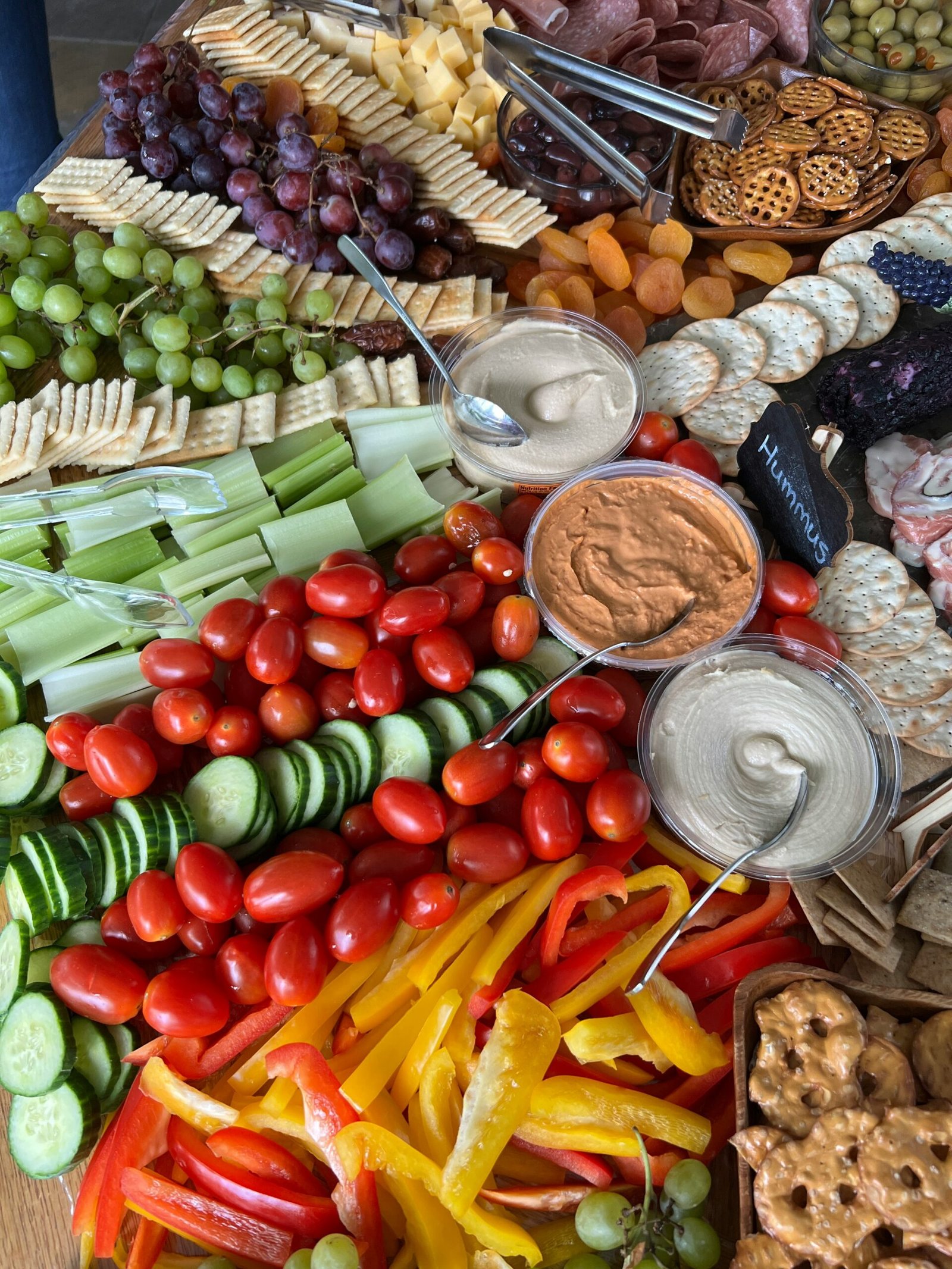Introduction to Buffalo Chicken Wings
Buffalo chicken wings, a dish synonymous with vibrant flavors and spirited gatherings, have an intriguing history that traces back to their origins in Buffalo, New York. The story goes that in the late 1960s, Teressa Bellissimo, seeking to satisfy her late-night patrons at the Anchor Bar, created this tempting snack by deep-frying leftover wings and tossing them in a zesty hot sauce made from cayenne pepper and butter. This accidental culinary innovation quickly caught on, elevating the humble chicken wing to new gastronomic heights and establishing it as a staple in American cuisine.
Over the years, buffalo wings have transcended their local roots to become a beloved dish enjoyed worldwide. Their irresistible combination of crispy texture and spicy sauce makes them a popular choice for various occasions, from casual family dinners to spirited Super Bowl parties. The appeal of buffalo wings lies not only in their flavor but also in their ability to bring people together, creating a communal dining experience that fosters camaraderie and celebration.
Reflecting on my first encounter with buffalo chicken wings, I recall the excitement that filled the air when they were served at a family gathering. The aroma of spicy sauce wafting through the room ignited our appetites, and I couldn’t wait to experience the delightful kick of heat that each wing promised. It became a tradition in our household, where we would gather around the table, share stories, and savor the deliciously messy fingers that inevitably came along with devouring the wings. The atmosphere was always lively, transforming an ordinary meal into a cherished family ritual.
Today, buffalo chicken wings continue to garner admiration across the globe, evolving with various regional twists and an array of creative accompaniments. Whether served with creamy blue cheese dressing or alongside crunchy celery sticks, their timeless appeal remains unquestionable. The journey of buffalo wings from a small bar in Buffalo to tables worldwide is a testament to their enduring popularity and the joy they bring to our culinary experiences.
What Makes Buffalo Sauce Special?
Buffalo sauce is renowned for its bold and distinctive flavor, which elevates a variety of dishes, particularly chicken wings. The key ingredients that contribute to this signature taste include hot sauce, vinegar, and butter. The combination of these elements creates a unique profile that is both spicy and tangy, appealing to those who enjoy a heat-infused culinary experience.
The primary component of buffalo sauce is hot sauce, typically made from aged cayenne peppers, vinegar, and salt. This fiery ingredient provides the quintessential heat that buffalo sauce is famous for. Notably, the most popular hot sauces used in buffalo sauce recipes include Frank’s RedHot, which is often cited as the original sauce for authentic buffalo wings. The acidity from the vinegar enhances the pepper’s heat, giving it a lively, zesty quality that excites the palate.
Another critical ingredient is butter, which plays a vital role not only in flavor but also in texture. By adding melted butter to the hot sauce, it creates a smooth, creamy consistency that balances the fiery heat with richness. This buttery element mellows the sharpness of the vinegar and contributes to the overall deliciousness that buffalo sauce offers. Additionally, some gourmet versions of the sauce might incorporate other ingredients such as garlic powder or Worcestershire sauce, providing a deeper flavor profile and inviting complexity.
Fun trivia about buffalo sauce reveals that it originated in Buffalo, New York, in the 1960s, at the Anchor Bar. It was an impromptu creation intended to utilize leftover chicken wings. Since then, it has gained immense popularity and has become a staple in many kitchens around the world, particularly for game days and gatherings. Today, buffalo sauce continues to evolve, with variations that cater to diverse taste preferences while maintaining its classic appeal.
The Perfect Chicken Wings: Types and Cuts
When it comes to preparing the perfect chicken wings, understanding the various types and cuts is essential. Chicken wings are generally classified into three primary cuts: whole wings, drumettes, and wingettes. Each cut offers a unique texture and flavor, making them suitable for different culinary purposes. Whole wings consist of the wing tip, drumette, and wingette all attached, providing a complete wing experience. They are often favored for their presentation and can be served at gatherings where aesthetics matter.
Drumettes resemble small drumsticks and are particularly popular for buffalo sauce due to their meaty texture. Wingettes, on the other hand, are the flat sections of the wing, comprising two distinct bones. This cut tends to yield more crispy skin, making it an ideal choice for frying or baking. For those seeking to create a classic buffalo wing experience, the drumette or wingette are the most recommended cuts. Each of these cuts is capable of absorbing the flavors of the spicy buffalo sauce exceptionally well, enhancing the overall taste.
Market variations can influence the availability of the different cuts of chicken wings. It is advisable to source wings from reputable suppliers or local farms that prioritize quality. Fresh chicken wings should appear plump and moist with a pale pink hue. When purchasing, consider looking for wings that are labeled as organic or free-range, as these are often more flavorful and ethically sourced. The right selection of chicken wings not only affects the dish’s taste but also contributes to a more satisfying dining experience. By understanding the different types and selling points of chicken wings, one can enhance their culinary adventures in preparing homemade buffalo sauce.
Gathering Your Ingredients
To create the perfect spicy chicken wings with homemade buffalo sauce, it is essential to gather high-quality ingredients that will enhance the flavor of your dish. The following list outlines the necessary components along with their precise measurements and recommended brands for optimal desirability.
First and foremost, you will need two pounds of chicken wings. It is advisable to purchase fresh wings from a reputable butcher or grocery store, ensuring that they are free from preservatives. Organic options from brands like Bell & Evans or Perdue tend to provide superior flavor and quality.
Next, prepare to make the homemade buffalo sauce. For this, you will require 1 cup of hot sauce. Frank’s RedHot is a classic choice that delivers an authentic buffalo flavor, while Tapatío or Crystal Hot Sauce offers unique flavor profiles. Alongside the hot sauce, you’ll need ½ cup of unsalted butter, which is crucial for achieving that creamy consistency. Grass-fed options, such as Kerrygold, can enhance the richness of your sauce.
Additionally, gather two tablespoons of white vinegar. This ingredient balances the heat and richness of the sauce, making it essential for the perfect blend. If you prefer a touch of sweetness to counteract the spice, consider adding 1 tablespoon of honey or maple syrup.
For seasoning your wings, gather a teaspoon of garlic powder, a teaspoon of onion powder, and a teaspoon of smoked paprika. These add depth and a subtle smokiness to the dish. Salt and pepper should also be included to taste.
Finally, prepare to use cooking oil for frying or baking the chicken wings. For frying, canola or peanut oil works best, while olive oil is recommended for baking. With these ingredients on hand, you are well on your way to creating a satisfying and flavorful treat.
Preparation: Getting Ready to Cook
Before delving into the delightful process of cooking spicy chicken wings, it is essential to prepare them properly to ensure maximum flavor and tenderness. Begin by selecting high-quality chicken wings, preferably fresh, as they provide a better taste and texture compared to frozen options. Once you have your wings, it is crucial to clean them thoroughly to eliminate any impurities. Rinse the wings under cold water and pat them dry with paper towels. This will help enhance the ability of the marinade to adhere to the chicken.
After cleaning, take a sharp kitchen knife and trim any excess fat or loose skin from the wings. This step not only improves the appearance of the chicken wings but also reduces grease during cooking, resulting in a healthier dish. If desired, you can separate the drumettes from the wingettes; however, leaving them whole can offer a more rustic presentation.
The next step in preparation involves marinating the wings in buttermilk. This step is vital, as buttermilk contains enzymes that promote tenderness and flavor absorption. In a large mixing bowl, combine the chicken wings with enough buttermilk to fully submerge them. For added taste, consider mixing in spices such as garlic powder, onion powder, and even a touch of hot sauce to the buttermilk. Cover the bowl with plastic wrap, or transfer the wings to a resealable plastic bag, ensuring they are well coated. Allow the wings to marinate in the refrigerator for at least one to two hours; for even more flavorful results, leaving them overnight is ideal.
As the marinating process takes place, the wings will absorb not only the rich flavors of the buttermilk but also develop a tender texture that will result in a mouthwatering eating experience once cooked. Proper preparation sets the stage for a successful cooking adventure with your spicy chicken wings.
Homemade Buffalo Sauce Recipe
Creating the perfect homemade buffalo sauce is an enjoyable culinary endeavor that elevates your spicy chicken wings to a new level. To begin this flavorful adventure, you will need a few simple ingredients that are often staples in most kitchens. The primary components include hot sauce, unsalted butter, garlic powder, cayenne pepper, and vinegar, all of which collectively yield a rich and zesty flavor profile.
Start by selecting your favorite hot sauce, as this will serve as the foundation of your buffalo sauce. Many opt for the classic Frank’s RedHot, but you can experiment with varieties to custom tailor the spice level and flavor to your preference. In a medium saucepan, melt 1 cup of unsalted butter over low heat. Once melted, gradually whisk in 1 cup of your chosen hot sauce, ensuring that the mixture combines smoothly.
To achieve the ideal balance between heat and flavor, add 1 teaspoon of garlic powder and adjust the cayenne pepper to taste. A good starting point is ½ teaspoon, which can be increased for those who prefer a stronger kick. To enhance the overall flavor, incorporate 1 tablespoon of white vinegar. This will add a slight tanginess that complements the heat from the sauce.
After mixing all the ingredients, allow the sauce to simmer on low heat for about five minutes. This enhances the flavors and helps meld them together, resulting in a rich, velvety buffalo sauce. Remember to taste and adjust seasoning as necessary, bearing in mind that the sauce can always be made milder or spicier based on your individual preference.
Once prepared, this homemade buffalo sauce can be used immediately or stored in the refrigerator for up to a week. It serves as the perfect accompaniment to your spicy chicken wings, ensuring a delightful and savory experience. Enjoy crafting this family-tested recipe that captures the essence of homemade buffalo sauce.
Step-by-Step Cooking Instructions
To begin the process of making Spicy Chicken Wings with Homemade Buffalo Sauce, selecting the right wings is crucial. Opt for fresh, high-quality chicken wings as they will yield the best flavor and texture. Preheat your oven to 425°F (220°C) if you choose to bake the wings. For frying, heat oil in a deep fryer or a large heavy pot to approximately 350°F (175°C).
Start by cleaning the chicken wings. Rinse them under cold water and pat them dry with paper towels. Ensuring the wings are dry helps promote a crispy texture when cooked. If you prefer, you can separate the wing sections into drumettes and flats for easier serving. Next, season the wings with salt, pepper, and any additional spices you desire, such as garlic powder or paprika, for extra flavor.
If you are baking the wings, place them on a wire rack set over a baking sheet. This allows air circulation around the wings, preventing them from becoming soggy. Bake for about 40-45 minutes or until the wings are golden brown and crispy, flipping them halfway through for even cooking. On the other hand, if you opt to fry the wings, carefully lower them into the hot oil in small batches. Fry each batch for 8-10 minutes or until they are crispy and cooked through. Once done, transfer the fried wings to a plate lined with paper towels to drain excess oil.
While the wings are cooking, prepare your Homemade Buffalo Sauce. Combine melted butter, hot sauce, garlic powder, and vinegar in a mixing bowl. Once the wings are cooked, toss them in the sauce to fully coat each wing. Serve immediately with celery sticks and blue cheese or ranch dressing for dipping. This approach ensures a deliciously crispy exterior along with a tangy kick from the sauce, making your Spicy Chicken Wings an irresistible treat.
Serving Suggestions for Buffalo Chicken Wings
Buffalo chicken wings are a popular dish that can be enjoyed in various settings, from casual get-togethers to festive celebrations. When serving these flavorful wings, it is essential to complement them with a selection of side dishes and beverages that enhance the overall dining experience. A classic accompaniment for spicy chicken wings is celery sticks, which provide a refreshing crunch and help balance the heat of the buffalo sauce.
Alongside celery, blue cheese dressing is often the preferred dip for buffalo chicken wings. This creamy condiment not only adds richness to the meal but also helps to temper the spiciness of the wings. For those who prefer a tangier option, ranch dressing serves as an excellent alternative. These sauces can be served in small bowls alongside the wings, allowing guests to customize their flavor experience.
In terms of additional side dishes, consider serving the wings with a medley of vegetables. Carrot sticks, cucumber slices, or even a light salad can provide a healthy counterpoint to the deep-fried nature of the wings. Another popular choice is French fries or potato wedges, which offer a satisfying side that pairs well with the flavors of the buffalo sauce. Additionally, for a heartier option, consider coleslaw, which adds a crunchy texture and a hint of sweetness to balance the meal.
When selecting beverages to accompany buffalo chicken wings, both alcoholic and non-alcoholic options can elevate the experience. Lighter beers, such as lagers or pilsners, are traditional pairings that can complement the spicy flavors. For non-alcoholic choices, a refreshing lemonade or iced tea may provide a delightful contrast to the heat of the wings.
Ultimately, the key to serving buffalo chicken wings lies in balancing the bold flavors with complementary sides and beverages, creating a memorable dining adventure for all.

Spicy Chicken Wings with Homemade Buffalo Sauce
Ingredients
- For the chicken wings:
- 1 pound chicken wings tips removed
- 1 tablespoon olive oil
- 1/2 teaspoon salt
- 1/4 teaspoon black pepper
- For the buffalo sauce:
- 1 cup hot sauce
- 1/4 cup melted butter
- 1 tablespoon Worcestershire sauce
- 1/2 teaspoon garlic powder
- 1/4 teaspoon cayenne pepper
Instructions
- Preheat oven: Preheat oven to 400°F (200°C).
- Prepare chicken wings: In a large bowl, toss chicken wings with olive oil, salt, and pepper.
- Bake chicken wings: Place chicken wings on a baking sheet lined with parchment paper. Bake for 25-30 minutes, or until cooked through and crispy.
- Make the buffalo sauce: In a small saucepan, combine hot sauce, melted butter, Worcestershire sauce, garlic powder, and cayenne pepper. Bring to a simmer and cook for 2-3 minutes, or until combined.
- Toss chicken wings: Toss cooked chicken wings in the buffalo sauce.
- Serve: Serve immediately with your favorite dipping sauce, such as blue cheese or ranch.
- Tips:
- For a spicier buffalo sauce, add more hot sauce or cayenne pepper.
- You can also bake the chicken wings in the oven for 10 minutes, then finish cooking them on the grill for a smoky flavor.
- Serve chicken wings with celery sticks and carrots for a healthy snack.
- Enjoy your spicy chicken wings with homemade buffalo sauce!
Notes
Prep time: 15 minutes
Cook time: 25-30 minutes
Tips for Perfectly Crispy Wings
Achieving perfectly crispy chicken wings can significantly enhance your culinary experience, transforming your meal into a flavorful adventure. Whether you opt to cook your wings in the oven or utilize an air fryer, following a few expert tips will ensure they turn out delightfully crispy every time.
First and foremost, proper preparation is essential. Pat drying your chicken wings with paper towels is a crucial step. Moisture on the surface of the wings can lead to steaming instead of crisping during the cooking process. By thoroughly drying the wings, you create a better environment for achieving that coveted crispy texture.
Another effective technique is to use baking powder. When coating the wings, mix a tablespoon or two of baking powder with your seasonings before applying it to the wings. The alkaline nature of baking powder helps to raise the pH level of the skin, promoting a browning reaction that contributes to crispiness. It’s important to ensure you are using aluminum-free baking powder to avoid any potential off-flavors.
For oven baking, arrange the wings on a wire rack set over a baking sheet. This setup allows hot air to circulate around the wings, ensuring even cooking and an improved crispiness overall. Preheating your oven to a high temperature, ideally around 425°F to 450°F, also aids in obtaining crispy skin. Cook the wings for an appropriate duration, usually 40 to 50 minutes, flipping halfway through.
If you prefer using an air fryer, you will also achieve outstanding results. Set your air fryer to a temperature of around 400°F and cook for approximately 25 to 30 minutes, shaking the basket occasionally to ensure an even cook. Whether you choose an oven or air fryer, following these tips will elevate your spicy chicken wings into a delectable, crispy delight.
Buffalo Sauce Variations
Buffalo sauce is a versatile condiment that can be customized in numerous ways to suit personal preferences and enhance the flavor profile of spicy chicken wings. The classic buffalo sauce is typically made with a combination of hot sauce, butter, and vinegar. However, various variations can be created by adjusting the ingredients to cater to different heat levels and taste sensations.
One popular modification is to incorporate honey into the buffalo sauce. Adding honey not only balances the heat from the hot sauce but also introduces a delightful sweetness that pairs beautifully with the spiciness. This sweet and spicy combination can appeal to those who may be sensitive to heat but still want to enjoy the bold flavors of buffalo wings. A ratio of two tablespoons of honey to a cup of hot sauce can create a well-rounded flavor that favorites a broader audience.
For those seeking an extra kick, incorporating garlic or garlic powder into the buffalo sauce can elevate the overall flavor profile. Garlic adds a robust depth to the sauce, enhancing the spicy notes while offering an aromatic quality that is often sought after in wing recipes. A tablespoon of minced garlic or a teaspoon of garlic powder mixed into the base buffalo sauce can significantly modify the taste, resulting in a more complex and flavorful experience.
Additionally, experimenting with different types of hot sauces can create unique flavor variations. For example, using a smoky chipotle hot sauce will impart a rich, smoky flavor that contrasts the traditional vinegar tang found in standard buffalo sauce. Likewise, adding ingredients such as Worcestershire sauce, celery salt, or even a splash of lime juice can further customize the sauce to suit individual preferences, providing spicy chicken wings with an authentic, tailored touch.
Top Mistakes to Avoid When Making Buffalo Wings
Creating the perfect buffalo wings is an art that requires attention to detail and an understanding of common pitfalls. One prevalent mistake home cooks make is undercooking the wings. It’s essential to ensure that chicken wings are cooked thoroughly to an internal temperature of at least 165°F (74°C). Undercooked wings not only pose health risks but also fail to develop the desired texture. Using a meat thermometer can provide an accurate reading, ensuring your wings are both safe and succulent.
Another common error is neglecting the importance of drying the wings before cooking. Moisture on the wings’ surface can impede browning and result in a less than crispy texture. To avoid this, it is advisable to pat the wings dry with paper towels and let them rest in the refrigerator for an hour or two. This helps to open up the skin, allowing for a crispier finish when they are fried or baked.
Timing is also critical when making buffalo wings. Many cooks will skip the crucial step of preheating the oven or frying oil, which can lead to uneven cooking and undesirable results. Always ensure that your frying oil is heated to around 350°F (175°C) before adding the wings. Similarly, if you are baking them, preheating the oven allows for consistent cooking. Additionally, tossing the wings in the sauce during the last few minutes of cooking can prevent them from becoming soggy.
Finally, using low-quality sauces or failing to balance the flavors can detract significantly from the experience. Homemade buffalo sauce made with fresh ingredients typically offers a richer flavor than store-bought versions. Consider gentle adjustments in spice levels and acidity to achieve a more balanced sauce that enhances the flavor profile of your wings. By acknowledging these common mistakes and taking preventive measures, you can elevate your buffalo wing-making experience.
Storage and Reheating Tips
When it comes to enjoying buffalo chicken wings, proper storage is crucial to maintain their flavor and texture. After cooking a batch of spicy chicken wings, allow them to cool to room temperature. This prevents condensation from forming inside the storage container, which can make the wings soggy. Place the wings in an airtight container to keep them fresh for future enjoyment. Ideally, the stored buffalo wings should be consumed within three to four days, but you can extend their shelf life by freezing them.
To freeze leftover chicken wings, first, ensure they are completely cooled. Then, arrange the wings in a single layer on a baking sheet and place them in the freezer until they are firm. Once frozen, transfer the wings to a freezer-safe bag or container, removing as much air as possible to prevent freezer burn. Frozen buffalo wings can be safely stored for up to three months.
When it comes time to reheat the wings, there are several methods to restore their crispy texture. One of the best ways to reheat buffalo chicken wings is by using an oven. Preheat the oven to 350°F (175°C). Arrange the wings on a baking sheet lined with parchment paper, ensuring they are spread out and not crowded. Heat for about 15-20 minutes, flipping the wings halfway through the reheating process. This method helps to maintain their crispiness and ensures that the wings are heated evenly.
If you prefer a quicker option, a microwave can be utilized, but it may not yield the desired crispiness. Place the wings on a microwave-safe plate, cover them with a damp paper towel, and heat in increments of 30 seconds until warm. For a texture that is closer to the original, consider finishing the wings briefly in a hot skillet or under the broiler after microwaving.
Healthier Alternatives for Buffalo Wings
Beneath the excitement of savoring spicy chicken wings lies the consideration of health-conscious variations that can still deliver a burst of flavor. Traditional buffalo wings are often deep-fried, resulting in high-caloric content and added fat. However, alternative cooking methods, such as baking or air frying, can significantly reduce the amount of oil used while retaining the wings’ beloved crispiness. By simply marinating the wings in a flavorful buffalo sauce and then baking them, one can achieve a deliciously satisfying result without the guilt associated with fried foods.
In addition to cooking techniques, modifying the choice of protein can also contribute to a healthier eating experience. For those who seek lighter options, chicken tenders can be a great alternative. These cuts are often leaner than traditional wings and can be equally expressive when coated in homemade buffalo sauce. Grilling chicken tenders can also reduce unnecessary fat while enhancing flavor through the chargrilled experience.
For a plant-based alternative, cauliflower wings have gained popularity in recent years. Prepared by cutting cauliflower into florets, these bites can be baked or air-fried and tossed in buffalo sauce for a spicy treat. Cauliflower is not only lower in calories but also offers additional health benefits, including a good source of vitamins and fiber. This makes it an appealing option for those looking to reduce their meat consumption without sacrificing flavor.
By exploring these healthier alternatives, one can indulge in the spicy flavors of buffalo sauce while making necessary adjustments to nutritional content. The key is to enjoy these flavorful dishes without compromising overall health, making the experience of consuming buffalo wings both satisfying and balanced.
Buffalo Wings in Popular Culture
Buffalo wings have cemented their place in American food culture, serving as a beloved staple in various social gatherings and events. Originating from Buffalo, New York, these spicy chicken wings have transcended their regional roots to become synonymous with festivities and communal experiences across the country. A significant event that showcases the popularity of buffalo wings is the Super Bowl, where millions of Americans gather to watch the championship game. The combination of thrilling sports action and the shared enjoyment of buffalo wings creates a vibrant atmosphere, making them an indispensable part of this nationwide celebration.
In addition to sporting events, trivia nights at local pubs frequently feature buffalo wings on their menus, further solidifying their cultural significance. These fun gatherings not only highlight the delicious appeal of spicy chicken wings but also provide an engaging social experience. Patrons often savor the wings while testing their knowledge, enhancing the overall enjoyment of the evening. The casual nature of these trivia nights allows for buffalo wings to shine as finger food, fostering interaction among friends and encouraging a laid-back yet festive mood.
Furthermore, buffalo wings have become a go-to dish for casual gatherings and parties throughout the year. Their bold flavors and variety of sauces cater to a wide range of taste preferences, appealing to those who enjoy a little heat as well as those who favor milder options. The popularity of these wings has led to their presence at barbecues, birthday parties, and family dinners, proving that buffalo wings are not just food—they are a symbol of camaraderie and celebration. As they continue to be featured in various social contexts, buffalo wings remain firmly entrenched in the fabric of American culinary tradition.
Melody’s Personal Buffalo Wings Experience
Buffalo wings hold a special place in my heart, evoking cherished memories of family gatherings and lively social events. The aroma of spicy chicken wings wafting through the house often signaled the beginning of a weekend filled with laughter and camaraderie. Assembling loved ones around a table laden with these delectable morsels created an inviting atmosphere, where stories and experiences exchanged hands as easily as the wings themselves.
My journey into the world of buffalo wings began during a casual barbecue hosted by friends. The combination of crispy skin, succulent meat, and the tangy, spicy homemade buffalo sauce captivated my palate, igniting a passion for recreating that experience in my own kitchen. I quickly learned that the process of making buffalo wings was not just about the final product; it was about the experience itself—preparing the wings together, mixing the sauce, and sharing the success (or occasional misstep) that would arise during the cooking process.
Over the years, I have hosted my share of buffalo wing nights, where friends and family would gather to taste various flavor profiles, from the classic spicy version to adventurous variations infused with garlic or honey. The excitement in the air during those gatherings offered not just a feast for the taste buds but also an opportunity to forge deeper connections. Exploring different recipes and customizations became a delightful challenge—a testament to the versatility of buffalo wings.
Whether it was a casual weeknight or a festive celebration, the act of enjoying spicy chicken wings transcended mere dining; it transformed into a bonding experience. Sharing this delicious dish allowed us to break down social barriers and foster relationships, proving that buffalo wings are more than just a snack—they are an embodiment of community, joy, and togetherness.
Reader Engagement: Share Your Experience
As you embark on your culinary journey to create the perfect spicy chicken wings with homemade buffalo sauce, we invite you to share your experience with us. Cooking is not just about following a recipe; it’s about discovering flavors, experimenting, and connecting with others. Your insights and modifications to this recipe can inspire fellow cooking enthusiasts and add to our collective joy of food.
Have you decided to tweak the traditional buffalo sauce recipe to accommodate your taste preferences? Perhaps you prefer a milder kick or have discovered a unique condiment that elevates the flavor profile of your wings. Whatever your story may be, we want to hear it! Sharing your experience not only enhances your cooking adventure but also engages our community of food lovers, all eager to learn and create delicious dishes.
Feel free to drop your comments below with any tips or tricks you’ve uncovered, or let us know how the spicy chicken wings turned out for you. Did you pair them with a refreshing beverage? Did you prepare them for a special occasion or family gathering? Each tale brings us closer together as a community united by our passion for cooking.
Additionally, if you’ve taken photos of your wings, we encourage you to share them with us. Visual representation adds a delightful dimension to our experiences as we appreciate the artistry involved in cooking. By participating in this dialogue, you contribute to a vibrant exchange of ideas and inspiration. Embrace this opportunity to connect, learn, and savor the joy of food preparation. We look forward to reading your stories and engaging with each of you in the comments section!
Frequently Asked Questions (FAQs)
Buffalo wings have become a staple in many cuisines, renowned for their bold flavors and exciting heat. Below are some common questions relating to the preparation, cooking techniques, and variations of buffalo wings, which can enhance your culinary experience.
What is the best method for cooking chicken wings? When preparing chicken wings, there are multiple cooking methods available, including frying, baking, and grilling. Frying offers a crisp exterior, while baking provides a healthier alternative without sacrificing flavor. For baking, preheat your oven to 400°F (200°C) and bake for approximately 40-45 minutes, flipping halfway through for even cooking. Grilling is another excellent option that infuses a smokiness into the wings, requiring you to cook them over medium heat for around 20 minutes, turning continuously for optimal results.
How can I make buffalo sauce at home? Creating homemade buffalo sauce is quite straightforward. The basic ingredients include melted butter, hot sauce, and a pinch of garlic powder. Combine one cup of hot sauce, such as Frank’s RedHot, with half a cup of unsalted melted butter and mix well. For added zest, consider incorporating Worcestershire sauce or cayenne pepper. Adjust the ratio of hot sauce to butter based on your heat preference.
What are some variations of buffalo wings? While traditional buffalo wings are known for their zesty flavor, there are numerous variations to explore. For a different twist, try Asian-style buffalo wings, incorporating soy sauce, ginger, and sesame oil for a unique flavor profile. Alternatively, consider smoked wings that impart rich flavors and can be paired with diverse sauces, like honey mustard or barbecue sauce. Additionally, vegetarian and vegan options have emerged, using cauliflower as a substitute for chicken, providing an equally appealing spicy snack.
By addressing these frequently asked questions, home cooks can become more knowledgeable and confident in their buffalo wing preparations, ultimately resulting in a flavorful culinary adventure.
Additional Resources for Buffalo Sauce Lovers
For enthusiasts eager to explore the diverse and tantalizing world of buffalo wings and sauces, there are a wealth of resources available. Whether you seek to master your homemade buffalo sauce or discover variations of this beloved dish, the following suggestions cater to every palate.
Starting with cookbooks, “Buffalo Style: The Best of Buffalo Wings” by Scott H. Hughes is a comprehensive guide that not only covers traditional recipes but also presents innovative twists on classic buffalo flavors. Additionally, “Wings: A Cookbook” by John H. Smith provides an extensive repertoire of wing recipes, emphasizing regional styles and unique sauces that can elevate your cooking skills.
For those who prefer online resources, several notable websites and blogs cater specifically to chicken wing enthusiasts. Sites like Food Network and Serious Eats feature a variety of recipes, cooking techniques, and tips on how to create the perfect buffalo sauce. Moreover, online forums such as Reddit’s Cooking subreddit provide a platform where aficionados can exchange insights, share their original recipes, and discuss their favorite buffalo sauce brands.
Video tutorials on platforms such as YouTube are also invaluable for visual learners. Channels dedicated to cooking often showcase detailed guides on making homemade buffalo sauce, providing tips on achieving the ideal balance of heat and flavor. Additionally, many of these videos feature taste tests that can inform your choice of ingredients and techniques based on expert opinions.
Embarking on the flavorful adventure of buffalo wings and sauce offers not only a culinary experience but also a delightful way to connect with others who share your passion. Exploring these resources will undoubtedly enhance your knowledge and inspire creativity in your kitchen.
Conclusion: Try the Recipe Today!
Embarking on the culinary journey of preparing Spicy Chicken Wings with Homemade Buffalo Sauce not only satisfies your taste buds but also brings the excitement of home cooking to your kitchen. The process allows you to explore various flavors, adjust the heat levels to suit your preferences, and create a dish that is perfect for gatherings or a simple family dinner. Cooking at home can be an immensely satisfying experience, granting you the opportunity to showcase your cooking skills while indulging in a delicious meal.
Making your own buffalo sauce adds a unique touch to the dish, allowing you to experiment with different ingredients, creating a sauce that is just right for your palate. The homemade version of this spicy delight is fresher and provides a deeper flavor profile compared to store-bought alternatives. With just a few ingredients, you can transform ordinary chicken wings into a gourmet snack that pleases both the senses and the appetite.
Furthermore, the joy of sharing your culinary creations with family and friends is second to none. Whether you serve them as an appetizer at a party or as the main attraction at a game day gathering, these wings are sure to become a crowd-pleaser. The satisfaction derived from preparing a meal from scratch and witnessing the enjoyment on your guests’ faces adds to the overall experience.
So why wait? Gather your ingredients, fire up your oven or grill, and take the plunge into making your own spicy chicken wings. Enjoy the process, relish the flavors, and create memories as you savor these delightful treats. Try the recipe today and embark on your flavorful adventure in cooking!














